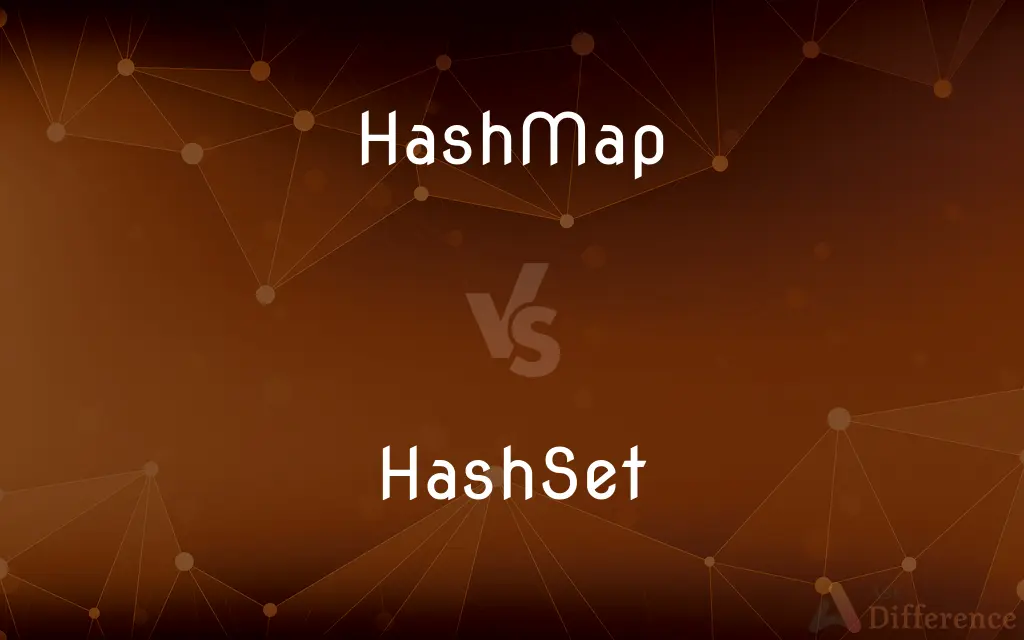HashMap vs. HashSet — What's the Difference?
Edited by Tayyaba Rehman — By Fiza Rafique — Published on December 8, 2023
HashMap is a map-based collection storing key-value pairs, while HashSet is a set collection storing unique elements. Both are part of Java's Collections Framework.

Difference Between HashMap and HashSet
Table of Contents
ADVERTISEMENT
Key Differences
HashMap is a part of Java's collection framework that facilitates the storage of pairs of objects, specifically as key-value pairs. In contrast, HashSet is another part of the same framework but allows the storage of individual objects, ensuring that each object is unique.
The uniqueness in a HashMap is based on keys. That is, every key in a HashMap is unique and associated with a specific value. Conversely, HashSet ensures that every element in the set is distinct, without any duplicate values.
One of the primary uses of HashMap is in situations where there's a need to associate specific information (value) with a unique key. This facilitates quick retrieval based on that key. On the other hand, HashSet is valuable in scenarios where there's a need to maintain a list of unique items, such as in a list of students in a class.
Both HashMap and HashSet have their internal mechanisms to maintain the uniqueness of their elements. HashMap achieves this by using a hashing mechanism on the keys, whereas HashSet uses a similar mechanism on the entire element.
In terms of performance, HashMap provides constant-time performance for most operations like get and put, assuming the hash function distributes the elements properly. HashSet offers constant time for basic operations like add, remove, and contains, again, given a good hashing mechanism.
ADVERTISEMENT
Comparison Chart
Primary Function
Stores key-value pairs
Stores individual unique objects
Uniqueness Based On
Keys
Elements
Usage
Associating specific information with unique keys
Maintaining a list of unique items
Internal Mechanism
Hashing mechanism on keys
Hashing mechanism on entire element
Typical Methods
Put(), get(), remove()
Add(), remove(), contains()
Compare with Definitions
HashMap
Facilitates quick data retrieval using keys.
Using a HashMap, you can quickly find the age of a person based on their name.
HashSet
A collection storing unique elements.
A HashSet can ensure that a list of names doesn't have duplicates.
HashMap
A part of Java's collection that ensures unique keys.
In a HashMap, you cannot have two entries with the same student ID.
HashSet
Suitable for maintaining a distinct list of items.
Using a HashSet, you can maintain a unique list of registered email addresses.
HashMap
Offers constant-time performance for basic operations.
The get method in HashMap retrieves values efficiently using the associated key.
HashSet
Provides constant-time performance for primary operations.
The add method in HashSet quickly adds an item if it's not already present.
HashMap
Uses a hashing mechanism to store data.
HashMap ensures data distribution through hashing of keys.
HashSet
A part of Java's collection that avoids duplicates.
Using a HashSet, a list of attendees will have each person only once.
HashMap
A collection storing key-value pairs.
A HashMap can store names of students (keys) and their grades (values).
HashSet
Utilizes a hashing mechanism for data storage.
HashSet distributes data efficiently using hashing.
HashMap
Alternative spelling of hash map
Common Curiosities
What does HashMap primarily store?
HashMap primarily stores key-value pairs.
How does HashSet ensure uniqueness?
HashSet ensures each stored element is distinct.
Are HashMap and HashSet synchronized?
No, neither HashMap nor HashSet is synchronized.
How many null elements can HashSet contain?
HashSet can contain only one null element.
How does HashSet determine if two elements are the same?
HashSet uses the equals() method and the hashing mechanism to determine uniqueness.
Is it possible to convert a HashMap to a HashSet?
Yes, by extracting keys or values from the HashMap and adding them to a HashSet.
Can two different keys in a HashMap have the same value?
Yes, keys are unique in HashMap, but their associated values can be identical.
What happens when two keys in a HashMap have the same hash value?
This is called a collision, and the entries are stored in a linked list in the same bucket.
Can a HashMap store null keys or values?
HashMap can store one null key and multiple null values.
What is the initial capacity and load factor in a HashMap?
By default, HashMap has an initial capacity of 16 and a load factor of 0.75.
How can you remove duplicates from an ArrayList in Java?
By adding the elements of the ArrayList to a HashSet, which automatically removes duplicates.
Why might one choose HashSet over a List?
HashSet ensures uniqueness of elements and offers efficient insertion, deletion, and search operations.
Which interfaces do HashMap and HashSet implement?
HashMap implements the Map interface, while HashSet implements the Set interface.
How can you improve the efficiency of a HashMap?
By ensuring a well-distributed hash function and optimal initial capacity and load factor.
Share Your Discovery

Previous Comparison
Abstract Class vs. Concrete Class
Next Comparison
Interpreter vs. AssemblerAuthor Spotlight
Written by
Fiza RafiqueFiza Rafique is a skilled content writer at AskDifference.com, where she meticulously refines and enhances written pieces. Drawing from her vast editorial expertise, Fiza ensures clarity, accuracy, and precision in every article. Passionate about language, she continually seeks to elevate the quality of content for readers worldwide.
Edited by
Tayyaba RehmanTayyaba Rehman is a distinguished writer, currently serving as a primary contributor to askdifference.com. As a researcher in semantics and etymology, Tayyaba's passion for the complexity of languages and their distinctions has found a perfect home on the platform. Tayyaba delves into the intricacies of language, distinguishing between commonly confused words and phrases, thereby providing clarity for readers worldwide.














































